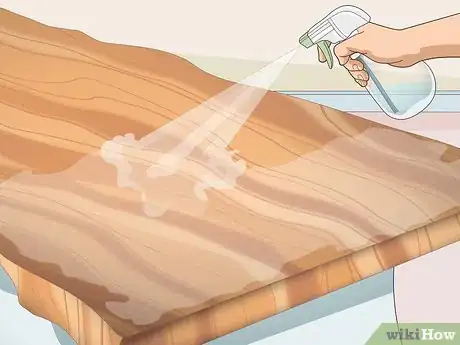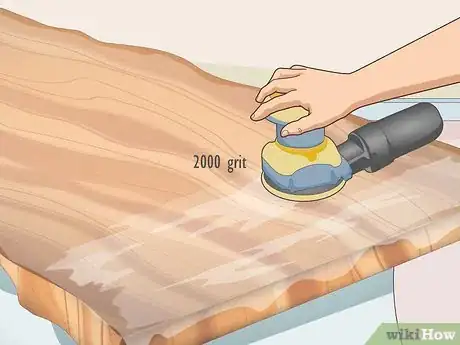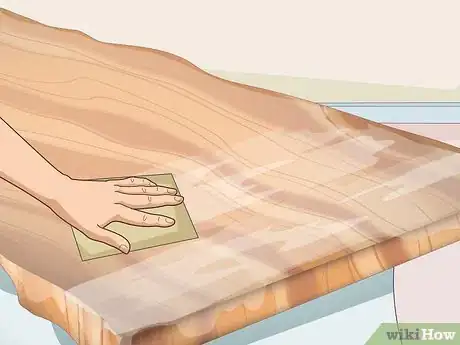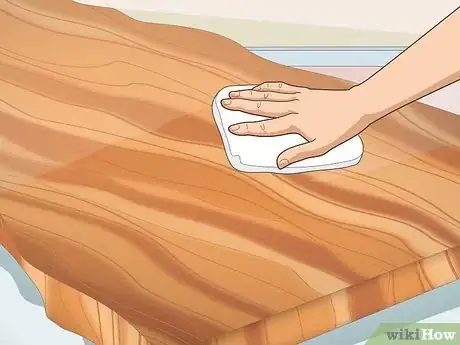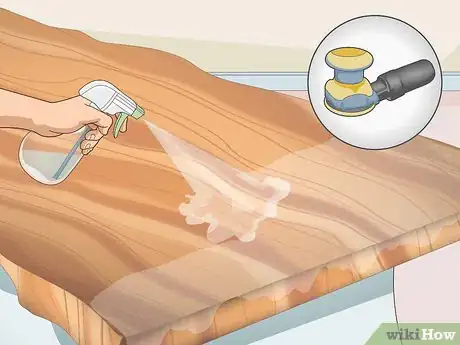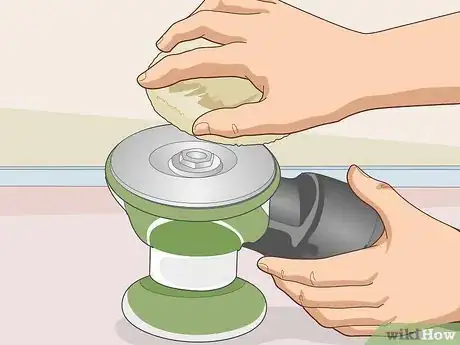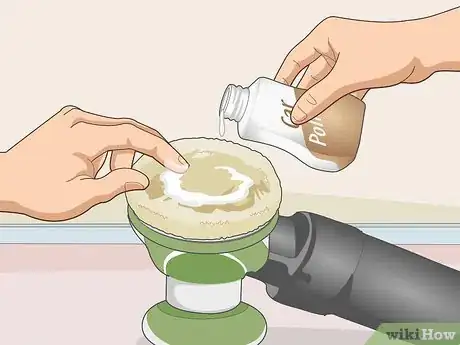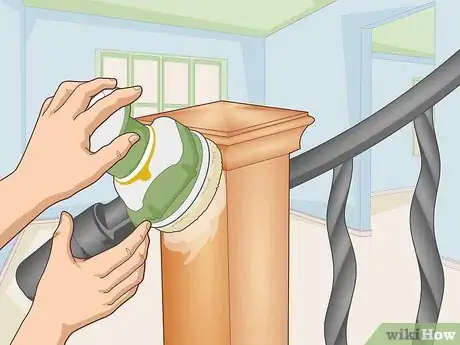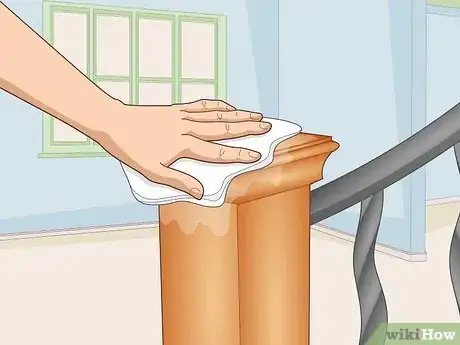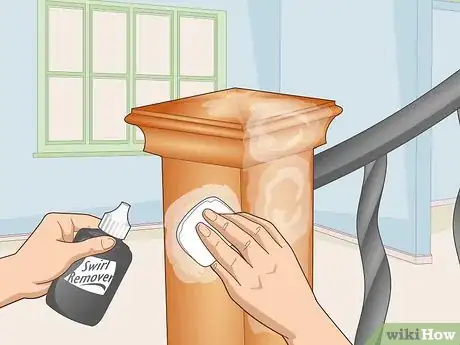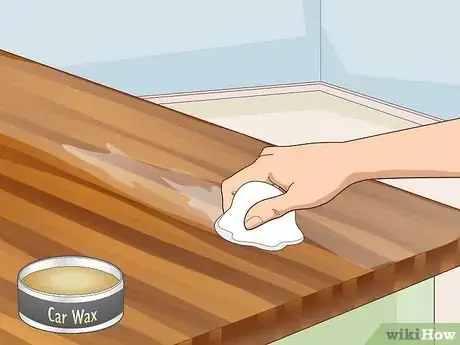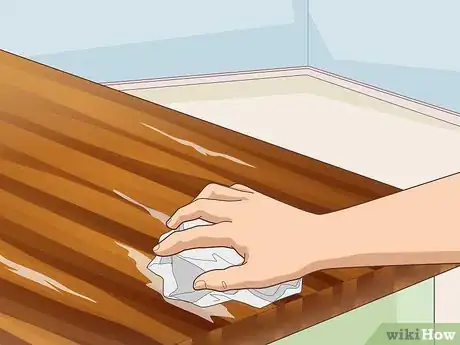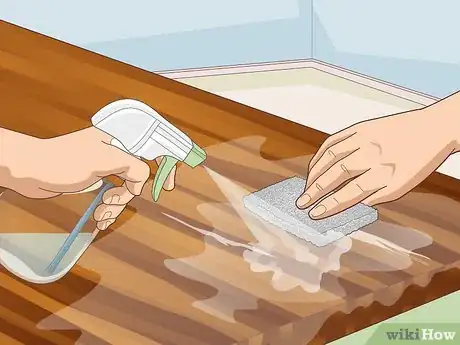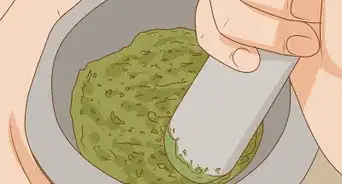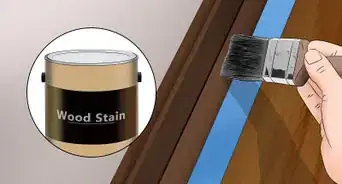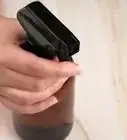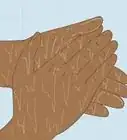This article was co-authored by wikiHow staff writer, Janice Tieperman. Janice is a professional and creative writer who has worked at wikiHow since 2019. With both a B.A. and M.A. in English from East Stroudsburg University, she has a passion for writing a wide variety of content for anyone and everyone. In her free time, you can find her working on a new crochet pattern, listening to true crime podcasts, or tackling a new creative writing project.
There are 14 references cited in this article, which can be found at the bottom of the page.
This article has been viewed 81,799 times.
Learn more...
Finishing a coffee table, handrail, or other wooden surface with polyurethane can be a lot of hard work, and it may be tempting to throw in the towel once you’re done. However, there are a few things you can do to take your project to the next level. While this polyurethane can help make your wood surfaces look smooth and glassy, it may feel a bit bumpy or uneven at first. To create a completely polished surface, it may be worth it to sand the surface of your wood. Buff the surface with car polish for a shiny finish or use paste wax for a satin finish.
Steps
Buffing the Finished Surface
-
1Spritz over the finished surface with tap water. After you’ve applied your polyurethane and let it dry completely, fill a plastic spray bottle with cool tap water. Lightly mist the surface with water so you can sand down the finish more efficiently.[1]
- When working with polyurethane, wet sanding is the best way to ensure a smooth finish.
-
2Use an orbital sander and 2000-grit paper to buff the wet surface. Take a circular sheet of smooth sandpaper and fit it into your sander. Turn the machine to a low power setting, then rub the sander in slow, horizontal motions across the surface. Apply a light, even amount of pressure so you can work away any scratches or bumps in the finish. Start on 1 side of the surface, then move the sander slowly to the opposite side.[2]
- Make sure that the sandpaper is labeled as “wet/dry.” You can find this type of paper at most hardware or home improvement stores, or you can buy it online.
Tip: You can also use a scrubbing pad with your orbital sander. Without inserting any sandpaper or buffing pads, rest the blank surface of the sander on top of the scrubbing pad. Once you turn your sander on to a low speed, the pad will spin and buff the finished surface. For a shinier finish, stick a soft buffing pad beneath your sander instead.[3]
Advertisement -
3Sand down the surface by hand if you don’t have a handheld tool. Use a smooth piece of sandpaper that’s around 1500-grit, then start rubbing down the finish in long, smooth motions. If you don’t have any sandpaper on hand, you can also use a brown paper bag to buff the surface.[4]
- If you don’t have any super-fine sandpaper on hand, you can use a lower grit level, like 320.[5]
- You may have an easier time sanding by hand if you wrap the sandpaper around a block of styrofoam.
-
4Wipe any residue from the surface with a clean cloth. As you buff the surface of your finish, look for any dust or slurry building up on the surface. When you see this residue, use a clean cloth to wipe and remove it from the surface gently.[6]
- Sanding polyurethane can be a time-consuming process, so you may have to do this several times.
-
5Repeat the spraying and sanding process until the surface feels smooth. Feel the surface of your polyurethane to see if the bumps and scratches are gone. If not, continue buffing in long, slow motions along the sides and edges of the surface. Try to go extra slowly and light along the edges so you don’t sand through the finish by mistake.[7]
- Switch out your sandpaper pad if it looks dirty or clogged with polyurethane slurry.[8]
- This process may take several minutes to complete. Don’t be discouraged if you don’t see results right away!
Using Polish for a Glossy Surface
-
1Insert a foam buffing pad in your orbital sander. Remove the sandpaper pad and replace it with a 1 in (2.5 cm) thick foam insert. If you’re having trouble switching or installing a new pad, consult your user manual for advice.[9]
-
2Spread a grape-sized amount of car polish onto the pad. Try to coat a good portion of the foam pad, then smear the polish on top of the finish. Make sure that the polish is clear, and not designed for dark exteriors.[10]
- You can buy car polish online, or in an auto supply shop.
- Feel free to use more or less polish, depending on the size of your project.
-
3Buff the polish into the finished project until the surface looks shiny. Turn your orbital sander onto a low speed and apply a small amount of pressure to the finished surface.[11] Work in long, horizontal motions to work the polish into the polyurethane.[12]
- Don’t be discouraged if the surface doesn’t look shiny right away. It’ll take a few minutes before the polish is completely buffed in.
- Be careful when you polish around the edges, as you don’t want to burn through the polyurethane.
-
4Use a polishing cloth to buff any residue into the surface. Rub the cloth in wide, circular motions along the entire finish. Continue wiping down the surface until it looks glossy and reflective.[13]
- This helps to get rid of any excess polish stuck to the surface.
-
5Rub a swirl mark remover onto the surface with a polishing cloth. Pour a blueberry-sized amount of automotive swirl mark remover onto a soft, clean polishing cloth, then wipe down the polished surface with circular motions. Once you’ve coated the entire surface, use another cloth to wipe off any excess.[14]
- You can find automotive swirl remover online, or in any store that sells auto supplies.
Tip: Glossy finishes are a great option for eye-catching items, like a coffee table or acoustic guitar.[15]
Waxing for a Satin Finish
-
1Rub the wax in the same direction as the grain. Add a pea-sized amount of car paste wax to a polishing pad or cloth. Work in short, smooth motions until there are no visible scratches in the polyurethane.[16] Move the pad in smooth, horizontal motions so you can apply an even coat of wax to the surface.[17]
- You can also use a section of 0000 steel wool to buff the surface.[18]
- To make things easier, apply wax to the end sections of the wood first. Always follow the grain when you do this!
- For a more careful polishing job, use short, smooth strokes as you go.
-
2Use a paper shop towel to clean off any excess wax. Before the paste wax has a chance to dry, use a sheet of paper shop towel to rub and get rid of any residue. Go over the entire surface with the towel in long, horizontal motions, picking up any leftover wax as you go.[19]
- You don’t want wax drying on your polyurethane, as this will make the surface feel uneven.
-
3Spray and rub down the surface with water if any wax dries. Sprinkle a few droplets of tap water over the entire waxed surface, which will bead on the surface of your waxed finish. Use a clean, 0000 steel wool pad to brush down the surface lightly from left to right. Once you’ve given the finish a good wipe, flip the pad and repeat the wiping process. Once you’ve gotten rid of any leftover wax, blot away the water with a cloth or paper towel.[20]
Tip: Satin finishes are great for functional items, like kitchen tables.[21]
Warning
- Make sure you’ve applied at least 3-4 coats of polyurethane before polishing it, or else you could burn through the finish.[22]
Things You’ll Need
Buffing the Finished Surface
- Spray bottle
- Water
- Orbital sander
- 2000-grit sanding pads
- Polishing cloth
- Scrubbing or buffing pad (optional)
Using Polish for a Glossy Surface
- Foam buffing pad
- Orbital sander
- Car polish
- Polishing cloth
- Swirl mark remover
Waxing for a Satin Surface
- Paste wax
- Polishing pad or cloth
- 0000 steel wool
- Spray bottle
- Water
References
- ↑ https://m.youtube.com/watch?v=96KywJlZ9g4&t=2m5s
- ↑ https://m.youtube.com/watch?v=96KywJlZ9g4&t=2m49s
- ↑ https://m.youtube.com/watch?v=PpUBzF0LSnM&t=2m55s
- ↑ https://www.woodmagazine.com/woodworking-tips/techniques/finishing/polyurethane
- ↑ https://m.youtube.com/watch?v=PpUBzF0LSnM&t=1m10s
- ↑ https://m.youtube.com/watch?v=96KywJlZ9g4&t=3m4s
- ↑ https://m.youtube.com/watch?v=96KywJlZ9g4&t=3m20s
- ↑ https://m.youtube.com/watch?v=96KywJlZ9g4&t=5m26s
- ↑ https://m.youtube.com/watch?v=96KywJlZ9g4&t=6m50s
- ↑ https://m.youtube.com/watch?v=96KywJlZ9g4&t=7m9s
- ↑ https://www.woodworkersjournal.com/rubbing-great-finish-satin-gloss/
- ↑ https://m.youtube.com/watch?v=96KywJlZ9g4&t=8m3s
- ↑ https://www.woodworkersjournal.com/rubbing-great-finish-satin-gloss/
- ↑ https://www.woodworkersjournal.com/rubbing-great-finish-satin-gloss/
- ↑ https://m.youtube.com/watch?v=96KywJlZ9g4&t=0m6s
- ↑ https://www.woodworkersjournal.com/rubbing-great-finish-satin-gloss/
- ↑ https://www.woodmagazine.com/woodworking-tips/techniques/finishing/polyurethane
- ↑ https://www.woodworkersjournal.com/rubbing-great-finish-satin-gloss/
- ↑ https://www.woodworkersjournal.com/rubbing-great-finish-satin-gloss/
- ↑ https://www.woodworkersjournal.com/rubbing-great-finish-satin-gloss/
- ↑ https://www.woodworkersjournal.com/rubbing-great-finish-satin-gloss/
- ↑ https://www.woodmagazine.com/materials-guide/finishes/what-finish-is-that-anyway
